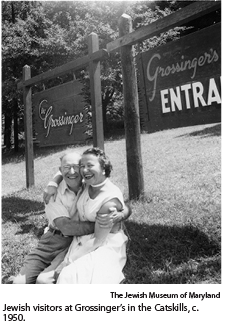By WILL McKINLEY
The Museum of Jewish Heritage honors a bygone era
Catskills on Film
October 24 at 7 p.m.
Museum of Jewish Heritage
36 Battery Place
(646.437.4202; mjhnyc.org)
Put away those sweaters, because summer is back — if only for one night. On Wednesday, October 24, the Museum of Jewish Heritage will present “Catskills on Film,” a retrospective of cinematic depictions of the warm weather wonderland beloved by generations of Jewish New Yorkers.
“A film is something that people can always take with them,” said Phil Brown, co-founder of the Catskills Institute and moderator for the evening of discussion and remembrance. “And there have been a few films that capture the essence of the Catskills in a wonderful way.”
One of those movies is “A Walk on the Moon,” a beautifully nuanced tale of personal discovery and romantic infidelity set in an upstate bungalow colony during the steamy summer of ’69.
“Throughout my life I had been explaining to people what bungalow colony life was all about,” said Pamela Gray, who wrote the critically acclaimed 1999 film and will be featured on the panel. “I told the story so many times that I came to realize it was a unique world. I wanted to tell this story and show a piece of Catskills life, and Jewish life, that most people hadn’t seen before.”
Gray, a Brooklyn native who vacationed in the Mountains until her teen years, spent eight years battling to bring a true-to-life representation of her deeply personal story to the big screen.
“The film industry looks at the surface. They assume that a movie with primarily Jewish characters will only appeal to Jewish people,” Gray said. “That was a big obstacle in getting the film made. It’s an uphill battle.”
In the end, Gray’s creative vision was realized, thanks in part to a producer named Dustin Hoffman. And the end result has delighted both Catskill veterans and those who wouldn’t know a bowl of borscht from a bucket of popcorn.
“The first thing they teach you when you’re studying creative writing is, the more specific you are, the more universal the story will be,” Gray said. “That’s what a writer dreams of — to be able to touch people and find that common humanity, even though the specifics may be different.”
Fellow panelist Shelly Altman, screenwriter of the sweetly nostalgic romantic comedy “Sweet Lorraine,” agrees about the importance of accuracy. Her 1987 film starred Maureen Stapleton as an aging hotel owner, a character based upon the writer’s grandmother, who owned a bungalow colony in Monticello for half a century.
“’Sweet Lorraine’ was the story of a Jewish culture,” Altman said. “The reason it was an independent film was to preserve that. We didn’t have to do battle because we wouldn’t let it become a battle. We were not willing to compromise on that.”
Set in a dying hotel, long past the region’s prime, “Sweet Lorraine” provides perhaps the most accurate depiction of Catskills hotel life ever committed to film. But it’s not just about mahjong tiles and kosher kitchens.
“It’s a very rich culture but, as with any movie, you need to have a story,” Altman said. “The Catskills isn’t the story. It’s the milieu. But there are many stories that can be told about the Catskills.”
Without question, the most well known story set in the Catskills is “Dirty Dancing,” the 1987 blockbuster that inspired a generation of middle school girls to practice mambo moves in the mirror. But, for the panelists who lived through the real thing, the film has tragic flaws that can’t be overlooked.
“When you ask people who really knew the Catskills what films to see, the answer is ‘Sweet Lorraine’ and ‘A Walk on the Moon’ more than ‘Dirty Dancing,’ ” said Brown, who has written one book about the region and edited another. “That hotel and the people in it don’t look authentic.”
Neither Altman nor Gray appear to take issue with the work of screenwriter Eleanor Bergstein, who based the iconic character of Baby on her own teenaged life as a doctor’s daughter and dance champion. But they are less than enthusiastic about the end result.
“When ‘Dirty Dancing’ came out there was recognition that people went to hotels in the Catskills,” Gray acknowledged. “Even though I consider that movie de-Jewed — it was never clearly stated that those were Jews — there was a recognition.”
Adds Altman: “I think it was not Catskills-specific. ‘Dirty Dancing’ could have taken place somewhere else and worked just as well.”
It’s that fiercely dogmatic pride of place that is honored in “The Other Promised Land: Vacationing, Identity, and the Jewish-American Dream,” the powerful exhibition at the Museum of Jewish Heritage through January, that inspired this symposium. There, amongst the archival photographs, black-and-white home movies and yellowing memorabilia from Mountain Meccas like Grossingers and The Concord, sits a hand-painted sign from the 1940s. “Gentiles Only” it says, in neat block letters. It’s a sad reminder of the prejudice that gave birth to what would become, at its height, the largest resort region in the world.
“It was a ghettoized community, because we were still a minority that could face discrimination,” Gray said. “This was part of the immigrant experience — to find places where you’re safe. That’s why there is so much nostalgia among the Jews that were in the Catskills. It’s a lost world.”
Rounding out the panel will be acclaimed filmmaker Joan Micklin Silver, director of “Hester Street,” “Crossing Delancey,” and an upcoming documentary that seeks to capture that magical world before it permanently recedes into history.
“People will come to this event with a lot of great stories and memories to share,” Brown said. “I feel like I have a responsibility to keep those memories alive.”


















